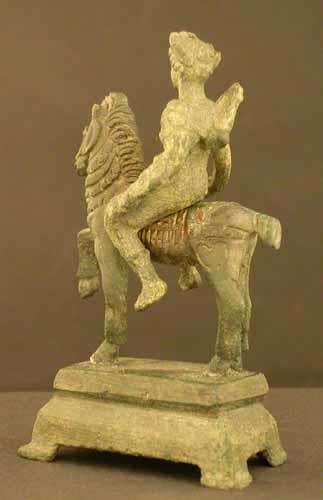Bronze Sculpture of a Horse and Rider, 100 CE - 200 CE
Bronze
1.75 x 3.5
FZ.392
Further images
Apollo, God of the Sun, son of Zeus and Leto, twin brother of Artemis, is one of the most important figures in the Olympian pantheon and the only Roman god...
Apollo, God of the Sun, son of Zeus and Leto, twin brother of Artemis, is one of the most important figures in the Olympian pantheon and the only Roman god to retain his original Greek identity. Apollo was the god of the arts, specifically music and poetry. One of his attributes is the lyre given to him by Mercury. Apollo was the father of the famed poet and tragic lover Orpheus and was a patron of the Muses. He was a master archer and a fleet-footed athlete, credited with having been the first victor in the Olympic games. Thus he is often depicted with a bow and quiver, crowned by a laurel wreath, a sign of victors much like gold medals are today. He was also associated with law, medicine, and philosophy.
The victorious Sun God strolls triumphantly, mounted on a proud stallion. The horse raises his front leg forward as he gallantly prances along, adorned with an ornate, elaborate bridle and saddle. The figure of Apollo comfortable controls the steed without holding the reins. The laurel wreath is seen crowning his head. His tunic wraps around his shoulder and flays in the breeze. In his right hand, Apollo holds a disc, perhaps an allusion to his Olympic competitions. The quiver on his back also enforces this idea. Overall, this diminutive sculpture is full of an energy and spirit much greater than its size. Such a noble work of art might have once honored an ancient athlete upon a great victory. Yet while victory is fleeting, the beauty of this stunning sculpture is eternal
The victorious Sun God strolls triumphantly, mounted on a proud stallion. The horse raises his front leg forward as he gallantly prances along, adorned with an ornate, elaborate bridle and saddle. The figure of Apollo comfortable controls the steed without holding the reins. The laurel wreath is seen crowning his head. His tunic wraps around his shoulder and flays in the breeze. In his right hand, Apollo holds a disc, perhaps an allusion to his Olympic competitions. The quiver on his back also enforces this idea. Overall, this diminutive sculpture is full of an energy and spirit much greater than its size. Such a noble work of art might have once honored an ancient athlete upon a great victory. Yet while victory is fleeting, the beauty of this stunning sculpture is eternal







